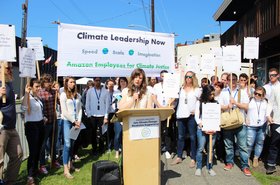After a 16-month investigation, House Democrats have published a 449-page report into whether Facebook, Amazon, Alphabet (Google), and Apple enjoy and abuse monopoly power.
The report concluded that Congress should change antitrust laws for the digital age, and "consider reasserting the original intent and broad goals of the antitrust laws, by clarifying that they are designed to protect not just consumers, but also workers, entrepreneurs, independent businesses, open markets, a fair economy, and democratic ideals." This could include breaking up some of the tech companies.
The investigation also delved into the question of cloud computing, and whether it was used by Amazon as a monopolistic tool. With Microsoft not a focus of the investigation, Azure is only mentioned in reference to AWS and Google Cloud, despite being the second-largest cloud provider. Google Cloud itself is briefly mentioned, with the report stating the division should be watched for anti-competitive conduct as it grows.
But for Amazon Web Services, the subcommittee dedicated significant resources into uncovering whether it acted as a monopoly and harmed competition. We read the report - here's what we found.
Follow the money
As the undisputed leader in cloud computing, AWS was a huge focus of the investigation, with the report seeking to understand how the business related to the wider Amazon enterprise, and whether it hurt its own customers.
For much of Amazon's life, as it cut retail costs to gain market share and aggressively expanded across the globe, its e-commerce business has operated at a loss. But AWS has always helped balance the company's books, accounting for more than 50 percent of the company's operating income, despite contributing less than 15 percent of revenue, on average.
In 2017, it accounted for all of the company's profits due to retail losses, while in the first quarter of this year it accounted for 77 percent of operating income, despite bringing in 13.5 percent of revenue.
All of this has led to claims "that Amazon uses its high and steady profits from AWS to subsidize other lines of business, including its retail operation," the report notes. In an internal document produced in response to the committee's requests for information, Amazon said that it instructs its employees to rebut this claim by referring to it as a 'myth.'
"However, Amazon failed to produce the financial data that would have enabled subcommittee staff to make an independent assessment."
Who has access to the data?
Another common concern is what Amazon can learn from the data it hosts for competitors or future adversaries. The issue was briefly brought up during a congressional hearing into Big Tech earlier this year, in response to an alleged anonymous ex-Amazon employee who claimed that "in the past, AWS proactively looked at [the] traction of products hosted on its platform, built competing products, and then scraped & targeted [a] customer list of those hosted products. In fact, I was on a team in AWS that did exactly that." As we pointed out at the time, CEO Jeff Bezos's answer to the allegation was vague at best.
The committee equally failed to find definitive proof either way, but said that "at least one market participant who spoke with subcommittee staff had evidence that AWS engaged in this cross-business data sharing." The nature or veracity of the evidence is not disclosed.
Engineers and market participants also raised concerns that AWS employees may have access to Amazon’s Key Management Services (KMS), which customers can use to store encryption keys. If an employee were able to access a customer’s encryption keys, they could potentially see the contents of a customer’s application, including proprietary code, business transactions, and data on their users. Amazon told the committee that the company’s “policies prohibit employees from accessing and reading customer keys in KMS. KMS is designed such that customer keys in the service cannot be retrieved in plain text unencrypted) form by anybody, including AWS employees."
Not mentioned in the report is that Amazon equally has an internal policy prohibiting the use of third-party seller data on Amazon.com to inform the development of in-house products, but that a Wall Street Journal investigation found that the practice was widespread and the policy was rarely enforced. “I can’t guarantee you that that policy has never been violated," Bezos told Congress in July.
What the report does mention, however, is that employees could still gain valuable competitive data even if they don't access the content of their customers' applications. AWS tracks a host of commercially sensitive metrics, including any changes in demand for storage and compute services, the components of their application’s architecture, the requests to a specific database per second, database size, and the types of requests.
One undisclosed industry expert told the committee: "They don’t need to see the encrypted content of a movie to see that there are a ton of requests to particular data. If Netflix announced five new movies this weekend and there’s a ton of data to five new objects. So, you don’t need all the information to know what’s happening."
Such data could allow Amazon to have an unrivaled insight into its competitors, but it can also help it make acquisition decisions. Back in 2011, Reuters reported that Amazon was using AWS to gain insights that helped it work out which companies to invest in or acquire, but did not provide specifics.
Amazon offers startups free credits, technical support, and training under its AWS Activate program. Subcommittee staff interviewed one such startup, who had engaged in partnership conversations with Amazon. A few years later Amazon had created a replica product.
The company said that Amazon "had so many incentives. Rate cuts, and free services. Not having a lot of resources, it’s hard to turn that down. But fast forward, we basically helped them build their offering that they copied from us.” A separate WSJ report alleges that Amazon created an investment fund to take stakes in startups, learn confidential data, and build competitors.
The subcommittee asked Amazon specifically whether it uses or has ever used AWS usage patterns or data to inform its investment decisions.
It replied: "AWS uses data on individual customers’ use of AWS to provide or improve the AWS services and grow the business relationship with that customer. This data may inform AWS’s decisions about how AWS invests in infrastructure, such as data centers, edge networks, hardware, and related software solutions in order improve the customer experience."
The report calls the response "unclear," and states that it doesn't clarify whether "it would view it appropriate to use a firm’s AWS data to develop products competing with that firm, so long as Amazon could identify some benefit to the broader 'customer experience.'"
Once you're in, you're in
The report is keen to note that AWS earned its dominant market position through an early mover advantage, network effects, and the high-fixed cost of building a competitor. But it adds that the company has taken steps to ensure that the customers it has gained in its meteoric rise will not leave.
With the largest collection of cloud offerings, tools, and products, AWS is the most commonly known platform for engineers. "Several market participants listed the availability of AWS-trained engineers as a reason for selecting AWS over other cloud vendors and as a barrier for switching platforms or attempting to multi-cloud."
The complexity and cost of switching puts off many AWS users. One cloud-based application company told subcommittee staff: "We've looked at other services (Google, Microsoft, Oracle) but relied on AWS for so long that we couldn't just flip a switch, and we've run down a lot of engineering problems with AWS. There are other providers we could go to, but it would take work. We could also build some functionality internally, but that would also take a lot of work."
Such disincentives to leave could be seen as a natural result of a cloud platform, but the committee found more specific cases of intentional lock-in.
When an Amazon customer chooses to move data to another cloud provider, they are charged an egress fee. Market participants told subcommittee staff that "they view these fees less as a cost for Amazon to transport data and more as friction imposed by Amazon for switching providers, noting that Amazon charges egress fees even when data is staying locally within the same data center." However, Amazon is not alone in charging egress fees.
It has another common tactic for keeping customers - pushing for long-term contracts. "Subcommittee staff also uncovered evidence that Amazon sometimes requires a volume agreement when a large company seeks to negotiate lower prices."
The investigation also found that Amazon used acquisitions to make it harder to leave. "In some instances, AWS has acquired cloud technologies that previously integrated with multiple clouds, only for AWS to make it an AWS-specific product after acquisition, foreclosing competitors, and increasing consumers’ switching costs." The report notes that Google has sometimes done the same.
Then there's what AWS has done to stymie open source tech that would make multi-cloud hosting easier.
Not so open source
When open source technology moved to the cloud, AWS was "able to use the data collected on their customers, including usage metrics, to learn which third-party software was performing well and ultimately to create their own proprietary version offered as a managed service."
One venture capitalist told the subcommittee that “open-source is critical for AWS getting market power. They’re standing on the shoulders of giants and they’re not paying the giants," while a cloud vendor added that “Amazon never built a database, never built cloud services, never built any of their AWS offerings. They took open source and offered it out on cloud. At the time that was innovative.”
The committee argues that AWS has developed many of its offerings using this practice and has created products that are only accessible as first-party offerings through the AWS Management Console."
One such example is the Amazon Elasticsearch Service (AESS), a first-party tool for searching and analyzing data. The product appears to be a copy of Elastic’s open-source Elasticsearch - and was generating more money than Elastic made within a year.
One reason for this was that AWS gave its own product preferential placement on the AWS Management Console. Another, as brought up in the Elasticsearch vs Amazon court case, is that AWS can name their replica products in a way that can mislead customers into believing that it is sponsored by the original open-source vendor.
It also provides some AWS functionality exclusively to its own products, such as the ability to run inside Amazon’s Virtual Private Cloud - something third-party offering aren't allowed to do.
The investigation uncovered evidence relating to "numerous instances in which Amazon has offered proprietary managed services based on knock-offs of open-source code."
Market participants told the subcommittee that when AWS creates its "knock-off" versions and adds new features, they "often only work with AWS infrastructure and are no-longer cross-platform - heightening the risk of lock-in."
One example is MongoDB and Amazon DocumentDB. The former is an open source document-based database project, the latter an Amazon version it prioritizes.
But if a customer uses DocumentDB, they are tied to AWS. "If they ever wanted to switch to another provider they would have to extensively re-engineer their product in another software."
This practice has also had a knock-on effect on the wider open source community, with companies closing off advanced features and changing licenses to be less permissive, for fear of suffering the same fate.
This, market participants claim, has significantly undermined innovation. Public sector users have also been impacted, with open source licenses becoming more restrictive, forcing them to use older versions of software from before the change.
The overall take
The committee said that "AWS has engaged in a series of business practices designed to maintain its market dominance at the expense of choice and innovation. Through a combination of self-preferencing, misappropriation, and degradation of interoperability, Amazon has sought to eliminate cross-platform products with Amazon-only products. Amazon’s conduct has already led several open-source projects to become more closed, a move driven by a need for protection from Amazon’s misappropriation.
"If unchecked, Amazon’s tactics over the long-term risk solidifying lock-in and diminishing the incentive to invest. Because cloud is the core infrastructure on which the digital economy runs, ensuring its openness and competitiveness is paramount."
Now what?
The report recommends imposing structural separations and prohibiting dominant platforms from entering adjacent lines of business. At an extreme, it could lead to Google having to divest YouTube, or Amazon having to divest AWS.
It also recommends antitrust agencies should presume mergers by dominant platforms are anticompetitive, with merging parties having to prove it would not harm competition.
The report says that dominant platforms should be blocked from preferencing their own services, and offer them on equal terms with competing products.
Dominant firms should also make their services compatible with competitors and allow users to transfer data - something that would have a huge impact on AWS.
And it also recommends increasing the budgets of the FTC and Department of Justice Antitrust Division, and requiring the FTC to regularly collect data on market concentration.
These are, of course, all recommendations - and by one party. Republicans have come out against the more aggressive proposals that call for potential company break-ups.
In a statement, Republican congressman and ranking member Jim Sensenbrenner said that “there actually is a lot that we agree on, including the lack of sufficient scrutiny on past activity by these companies.”
However, he said he was concerned with several of the recommendations made by the committee. "A ‘Glass-Steagall’ like approach to tech regulation [the Glass-Steagall Act, 1933, separated retail from investment banking in the US] does not benefit consumers and will lead to too much government regulation of a very innovative industry. Likewise, mandating data interoperability could hamper future innovation by preventing the development of new and better systems," he claimed.
Should the recommendations be enacted, they would mark the largest overhaul of antitrust reforms in more than four decades. The likelihood of such drastic change is unclear, with much relying on the outcome of this year's election. Who is president, and which party controls the House and Senate, will help decide whether any of the antitrust updates will gain traction.
The chairman of the subcommittee that produced this report, Rep. David Cicilline, told Bloomberg in August that he hadn't spoken to Biden about the investigation, but claimed that the candidate wouldn’t favor the “corporate mega-mergers that have resulted in this terrible imbalance in our economy." Axios reports that Biden was briefed on the report just before it was published.
DCD has contacted the Biden campaign for comment.
So far, the presidential candidate has indicated he would be more aggressive than the current administration on antitrust issues, but has steered clear of calling for break ups.
A policy task force Biden created with Senator Bernie Sanders, has recommended breaking up companies for anticompetitive behavior only “as a last resort.”
But whether any of the revelations in the report are worthy of last resort action is unclear. Whether we will find out depends on what happens in November.








